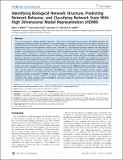Identifying Biological Network Structure, Predicting Network Behavior, and Classifying Network State With High Dimensional Model Representation (HDMR)
Author(s)
Miller, Miles Aaron; Feng, Xiao-Jiang; Li, Genyuan; Rabitz, Herschel A.
DownloadMiller-2012-Identifying Biologic.pdf (1.289Mb)
PUBLISHER_CC
Publisher with Creative Commons License
Creative Commons Attribution
Terms of use
Metadata
Show full item recordAbstract
This work presents an adapted Random Sampling - High Dimensional Model Representation (RS-HDMR) algorithm for synergistically addressing three key problems in network biology: (1) identifying the structure of biological networks from multivariate data, (2) predicting network response under previously unsampled conditions, and (3) inferring experimental perturbations based on the observed network state. RS-HDMR is a multivariate regression method that decomposes network interactions into a hierarchy of non-linear component functions. Sensitivity analysis based on these functions provides a clear physical and statistical interpretation of the underlying network structure. The advantages of RS-HDMR include efficient extraction of nonlinear and cooperative network relationships without resorting to discretization, prediction of network behavior without mechanistic modeling, robustness to data noise, and favorable scalability of the sampling requirement with respect to network size. As a proof-of-principle study, RS-HDMR was applied to experimental data measuring the single-cell response of a protein-protein signaling network to various experimental perturbations. A comparison to network structure identified in the literature and through other inference methods, including Bayesian and mutual-information based algorithms, suggests that RS-HDMR can successfully reveal a network structure with a low false positive rate while still capturing non-linear and cooperative interactions. RS-HDMR identified several higher-order network interactions that correspond to known feedback regulations among multiple network species and that were unidentified by other network inference methods. Furthermore, RS-HDMR has a better ability to predict network response under unsampled conditions in this application than the best statistical inference algorithm presented in the recent DREAM3 signaling-prediction competition. RS-HDMR can discern and predict differences in network state that arise from sources ranging from intrinsic cell-cell variability to altered experimental conditions, such as when drug perturbations are introduced. This ability ultimately allows RS-HDMR to accurately classify the experimental conditions of a given sample based on its observed network state.
Date issued
2012-06Department
Massachusetts Institute of Technology. Department of Biological EngineeringJournal
PLoS ONE
Publisher
Public Library of Science
Citation
Miller, Miles A. et al. “Identifying Biological Network Structure, Predicting Network Behavior, and Classifying Network State With High Dimensional Model Representation (HDMR).” Ed. Christina Chan. PLoS ONE 7.6 (2012): e37664.
Version: Final published version
ISSN
1932-6203